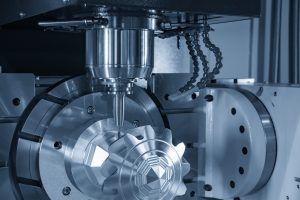The Definitive Guide to CNC Machine Maintenance
Mar 31, 2022 A CNC machine is a computer-aided machine used to create custom parts for a wide array of industries, including those in the medical, aerospace, and automotive industries. CNC machines are programmed to automatically employ multi-point cutting tools to move and gradually shape a piece of material into the desired shape.
A CNC machine is a computer-aided machine used to create custom parts for a wide array of industries, including those in the medical, aerospace, and automotive industries. CNC machines are programmed to automatically employ multi-point cutting tools to move and gradually shape a piece of material into the desired shape.
Precision CNC machines, like the ones used by our affiliates, are incredibly accurate (within 0.002 of an inch, or “tight tolerance”) and can produce a high volume of precision parts quickly. However, the machines must be maintained properly so that the components continue to be produced accurately and fit exact specifications.
Maintaining CNC Machines
CNC machines reduce the amount of labor in the manufacturing process, which leads to lower costs. While they are designed to operate continuously and withstand heavy use, they can break or malfunction when not maintained properly. This reduces productivity, delays shipments, and can cost your shop a significant amount of money in production downtime.
It’s best to perform preventive maintenance to avoid these problems altogether and keep your manufacturing operation running smoothly. Let’s look at how to stay on top of proper maintenance to keep your equipment operational and precise.
Overview of Basic Maintenance
First, identify the foundational aspects of maintaining a machine, such as keeping it clean and lubricated. It’s essential to check the following at different intervals:
- Lubrication – Grease and oil keep machines operating smoothly. Lubricate all moving parts to decrease wear on the machine.
- Fluid levels – Regularly check the hydraulic fluid levels in your CNC machines. If the machine frequently requires top offs of hydraulic fluid (or any other fluid), that can signal an issue.
- Coolant and cooling oils – The spindles in a CNC machine generate a lot of heat. Maintain coolant levels, temperature sensors, and cooling systems to prevent thermal problems.
Maintenance Intervals
There are different intervals recommended for CNC machine maintenance. Some manufacturers recommend specific intervals for their equipment or have unique parts that need separate care (you should also refer to those instructions). Still, the general rules and best practices are as follows:
Daily Maintenance
By performing these tasks daily, you’ll be able to preserve the useful life of your machine and catch any problems before they cause a breakdown:
- Wipe surfaces, clean any dirt or grime buildup, and remove metal shavings
- Grease moving parts
- Check and top off lubrication levels
- Empty the chip hopper
- Ensure coolant levels and concentration are satisfactory
- Assess hydraulic system levels
Monthly Maintenance
Each month, schedule a maintenance plan that includes:
- Cleaning cooling fans and radiators
- Examining and cleaning coolant filters
- Cleaning and replacing air filters
- Adjusting and greasing conveyors and chains
- Cleaning chucks and jaws
- Assessing oil fill checklists for excessive oil consumption
Annual Maintenance
Every year, your shop should complete in-depth maintenance for all CNC machines that includes the following:
- Inspect the chuck cylinder
- Run backlash program and replace X and Y-axis gibs
- Check the headstock and drawbar tension
- Remove the coolant tank, dispose of any stuck metal chips, and clean the entire system
- Replace hydraulic filters and check the hydraulic fluid for shavings or contaminants
- Change the machine’s oil
- Drain and clean the lubrication unit
It’s critical to stay current on each maintenance interval and keep detailed documentation of each task performed. Appropriate maintenance results in better performance and provides peace of mind for operators and supervisors who know the machines have been cared for properly, ultimately leading to a better functioning shop and business.
Investing in Technological Growth
Demmer Manufacturing is proud to support our portfolio companies’ growth by investing in their infrastructure, people, and technology. Visit our portfolio page to read more about our family of affiliates in the medical, aerospace, and precision machining industries. From there, you can visit their websites to see their unique innovations in their respective fields.

